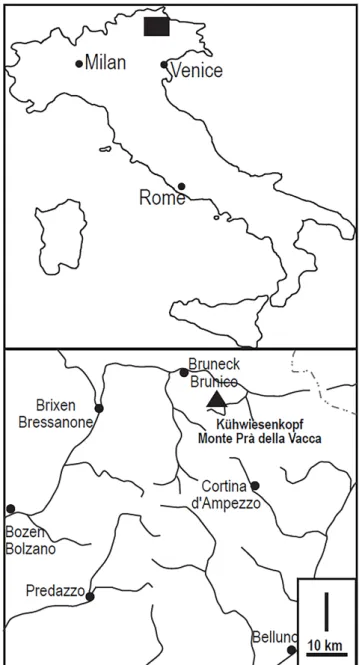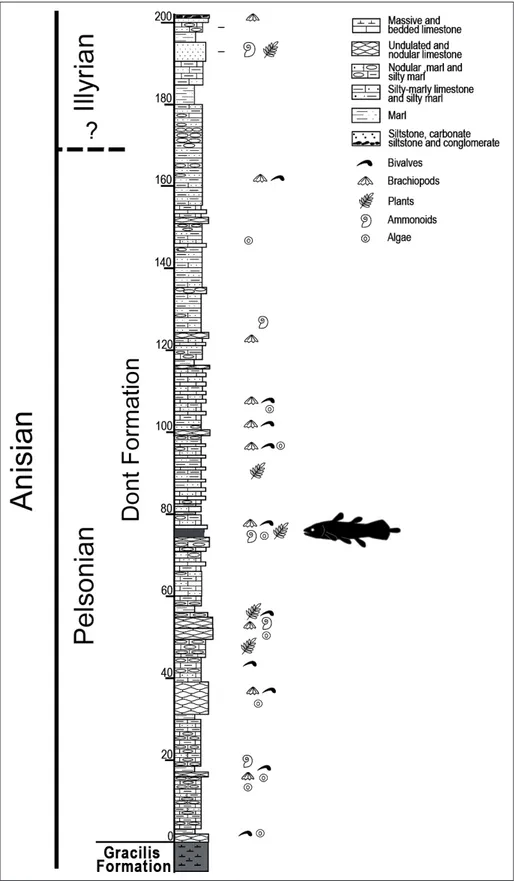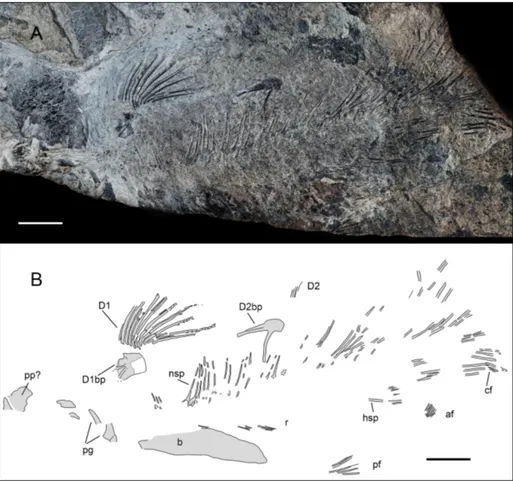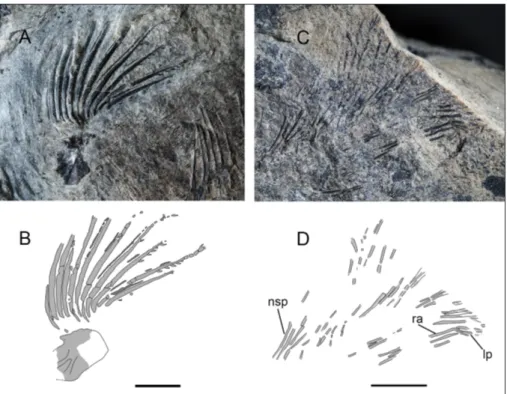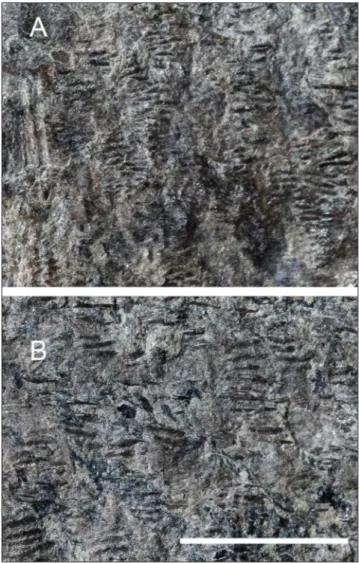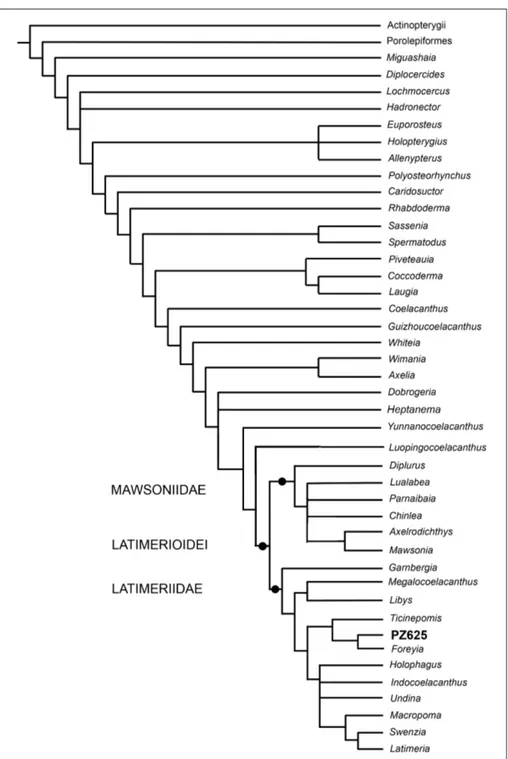A COELACANTH FISH FROM THE ANISIAN (MIDDLE TRIASSIC) OF THE DOLOMITES
SILVIO RENESTO1 & EVELYN KUSTATSCHER2, 3, 4
1Dipartimento di Scienze Teoriche ed Applicate, Università degli Studi dell’Insubria, Via Dunant 3 I 41100 Varese, Italy.
E-mail: [email protected]
2Museum of Nature South Tyrol, Bindergasse/via Bottai 1, 39100 Bozen/Bolzano, Italy.
3 Department of Earth and Environmental Sciences, Paleontology & Geobiology, Ludwig-Maximilians-Universität München,
Richard-Wagner-Str. 10, 80333 München, Germany.
4 SNSB-Bayerische Staatssammlung für Paläontologie und Geologie, Richard-Wagner-Str. 10, 80333 München, Germany.
To cite this article: Renesto S. & Kustatscher E. (2019) - A coelacanth fish from the Anisian (Middle Triassic) of the Dolomites. Riv. It. Paleontol. Strat., 125(2): 343-353.
Abstract. An incomplete coelacanthiform specimen is described from the Dont Formation (Anisian, Middle Triassic) of Kühwiesenkopf/Monte Prà della Vacca in the Northern Dolomites (NE Italy). Even if the incomplete-ness of the specimen does not allow a reliable taxonomic assignment at generic level, it increases our understanding of Middle Triassic coelacanthiform diversity in the western Tethys.
Received: February 01, 2019; accepted: April 05, 2019
Keywords: Actinistia; Anisian; Pelsonian; Northern Dolomites; UNESCO World Heritage.
I
ntroductIonCoelacanths (Actinistia) are a clade of sarcop-terygian fishes first known from the Early Devoni-an (JohDevoni-anson et al. 2006). They peaked in diversity in the Early-Middle Triassic, where they are mostly known from Euramerica (see Cavin et al. 2013 and Ferrante et al. 2017 for a reappraisal of European and American taxa) and China (Tong et al. 2006; Wen et al. 2013). Their diversity declines during the Cretaceous and they are completely absent from the Cenozoic fossil record. In fact, coelacanths were considered extinct at the end of the Mesozo-ic until a living specimen of Latimeria was
discov-ered in 1938 (Smith 1939). In the Alpine Middle Triassic, coelacanths are represented at Monte San Giorgio localities (an UNESCO world heritage site extending on both sides of the Italian–Swiss bor-der) by nearly complete specimens of Ticinepomis peyeri (Rieppel, 1980), and fragments of a larger
coelacanth tentatively referred to cf. Holophagus by
Rieppel (1985), from the Anisian–Ladinian Besano Formation (Grenzbitumenzone) while the genus
Heptanema is known both from the
Kalkschiefer-zone (Ladinian) of Monte San Giorgio and from the Perledo Varenna Formation (Ladinian) of Per-ledo (De Alessandri 1910; Renesto & Stockar 2018). Recently, the Prosanto Formation in the Duncan– Landwasser area near Davos (Canton Graubünden, eastern Switzerland), coeval with the Lower Meride Limestone (Ladinian), yielded large specimens of
Ticinepomis sp. cf. T. peyeri (Cavin et al. 2013) and the
highly derived taxon Foreya maxkuhni (Cavin et al.
2017). A reappraisal of the diversity of Middle Tri-assic coelacanths from Switzerland has been pub-lished by Ferrante et al. (2017).
In this paper we describe a new coelacanthi-form specimen, from the Dont Formation of Pel-sonian age (Anisian, lower Middle Triassic) of Küh-wiesenkopf/Monte Prà della Vacca site in Northern Dolomites (NE Italy) which yielded also a rich ac-tinopterygian fauna (Tintori et al. 2016) along with plant and tetrapod remains, as detailed in the fol-lowing sections.
G
eoloGIcal andGeoGraphIcal frameworkKühwiesenkopf/Monte Prà della Vacca (two names since the area is bilingual) is a mountain belonging to the Northern Dolomites, in the north-eastern part of the Dolomites (NE-Italy; Fig. 1). The Northern Dolomites are the fifth and most extensive of the nine systems of the UNESCO world heritage site Dolomites. The area is famous for its extensive and fossiliferous Anisian (Middle Triassic) outcrops, which record, within a few kilometres, the transition from emerged land to marine basin. Thus, it became a classical area for Anisian palaeontological (Loretz 1875; Mojsisovics 1879; Bittner 1890) and stratigraphical (e.g. Pia 1937; Bechstädt & Brandner 1970; De Zanche et al. 1992; Senowbari-Daryan et al. 1993; Broglio-Loriga et al. 2002) studies of the Southern Alps.
The here discussed section (Fig. 2) crops out on the northern slope of the mountain. It is a 200 m-thick succession of hemipelagic, terrigenous sediments, intercalated with more calcareous to calcarenitic units attributed to the Dont Formation (De Zanche et al. 1992; Senowbari-Daryan et al. 1993). The formation lays unconformable on a massive carbonate platform previously described as Algenwellenkalk by Bechstädt & Brandner (1970),
and now attributed to the Gracilis Formation (De Zanche et al. 1992; Senowbari-Daryan et al. 1993). In the uppermost part of the formation there is a considerable increase in the amount of terrigenous sediments (brownish siltstones, fine sandstones and conglomerates), which correspond to the Richthofen Conglomerate of the emerged areas. It is overlain by the basinal Livinallongo Formation (uppermost Anisian–lower Ladinian: Bechstädt & Brandner 1970; De Zanche et al. 1992, 1993; Gianolla et al. 1998). The Dont Formation is traditionally considered Pelsonian–Illyrian in age (Delfrati et al. 2000, with references), although in the Braies area (Rio Schade–Belvedere sections) were collected upper Bithynian ammonoids in the lower part of the Dont Formation (De Zanche et al. 1993; Gianolla et al. 1998). Ammonoids (e.g., Balatonites ex gr. balatonicus
(Mojsisovics, 1883) attribute a middle Pelsonian age (Balatonicus Subzone of Mietto & Manfrin 1995) to a bed located about 50 m above the fossil deposit (Kustatscher et al. 2006). Brachiopods (Bechstädt & Brandner 1970) and foraminifera (Fugagnoli
& Posenato 2004) of the Kühwiesenkopf/Monte Prà della Vacca section assign a Pelsonian age, palynomorphs a middle-late Pelsonian age to the fossiliferous horizon (Kustatscher & Roghi 2006; Kustatscher et al. 2006).
Palaeogeographic reconstructions of the late Anisian of this area (e.g., Bosellini 1968, 1989; Senowbari-Daryan et al. 1993; Zühlke 2000) position Kühwiesenkopf/Monte Prà della Vacca in a marine environment. Some emerged land was probably located to the ovest and to the south (the north-south oriented “dorsale badioto/gardenese”, sensu Bosellini 1968). During the early Pelsonian the area was characterised by a fluvial to marginal marine
Fig. 1 - Geographical map showing the position of the Kühwiesen-kopf/Prà della Vacca site.
environment. This environment was inundated probably from the north to northeast during the middle-late Pelsonian, creating first a lagoonal and later a shallow basinal environment, where also carbonate ramps were formed. Considering the composition of the plant assemblages and their requested environments, the emerged land was
probably covered by an extensive lowland (~50% of the plant assemblage has been attributed to this type of environment), rich in water availability and nutrients and with a low stress level for the plants. The highland or hinterland, environments above the groundwater level exposed to (seasonal?) periods of aridity was also well represented (~ 33% of the plant
Fig. 2 - Stratigraphic section of the Dont Formation at Mon-te Kühwiesenkopf/MonMon-te Prà della Vacca; coelacanth shape indicates the main fossiliferous level that yield-ed the coelacanth specimen.
assemblage), whereas coastal circa 6%) and river elements (circa 11%) are less abundant (Kustatscher et al. 2010b). The marine basins were characterized during this time interval by very diverse marine depositional environments, probably related to the very active Anisian tectonics (e.g. Pia 1937; Bosellini 1968; Pisa et al. 1979). This gave origin to a variety of ecological niches, from peritidal to basinal (Posenato 2008b).
A rich, fossiliferous horizon is placed about 75 m from the base of the formation. The horizon is about one meter thick with the fossils concentrated in some centimetres-thick layers of siltstone, marly siltstone and carbonate siltstone. The plant-rich lay-ers are lens-shaped, changing laterally in number and thickness. They alternate with silty and marly limestone layers with only sparce terrestrial plant remains. The plant-rich layers did not yield only an exceptionally abundant and diverse terrestrial mac-roflora (Broglio-Loriga et al. 2002; Van Konijnen-burg-van Cittert et al. 2006; Kustatscher et al. 2007, 2009, 2010a, 2010b) but also the terrestrial lepido-saur reptile Megachirella wachtleri is of particular
im-portance since it is the oldest known stem squamate (Renesto & Posenato 2003; Renesto & Bernardi 2013; Simoes et al. 2018). Marine biota (bivalves, brachiopods, ammonoids, gastropods and fishes) are present, though not abundant, throughout the hori-zon (Broglio-Loriga et al. 2002; Posenato et al. 2004; Tintori et al. 2001, 2016). Tintori and colleagues (2001) interpreted the occurrence and preservation of terrestrial (plants and reptiles) and marine fossils are presumably related to a “very rapid burial events caused by gravity flows within a marine basin, con-nected with heavy storms in the terrestrial domain”. The fossiliferous horizon can be interpreted as an obrution deposit related to large, single or multiple fresh-water influxes from a nearby land into the ma-rine basin of the Dont Formation (Broglio-Loriga et al. 2002). Consequently, large amounts of fine clas-tics were transported into the basin, possibly at high energy and turbulence. Terrestrial organisms were transported together with the sediment, while fishes and marine invertebrates probably died because of the abrupt supply of sediments reaching the basin and the dramatic drop in salinity caused by the con-siderable income of fresh water (Broglio-Loriga et al. 2002; Tintori et al. 2016).
The fossil plant assemblage of Kühwiesen-kopf/Monte Prà della Vacca comprises at least 35
taxa belonging to lycophytes, horsetails, ferns, seed ferns, cycadophytes and conifers (Broglio-Loriga et al. 2002; Van Konijnenburg-van Cittert et al. 2006; Kustatscher et al. 2007, 2009, 2010a, 2010b). Ferns, cycadophytes and conifers are the most abundant elements in the flora, lycophytes and seed ferns are common, and horsetails are rare. The plant as-semblage reflects a typical European Anisian flora but has also a high affinity with Chinese floras (e.g., Kustatscher et al. 2010b; Tintori et al. 2016). The succession is characterized by several brachiopod beds (Loretz 1875; Mojsisovics 1879; Bittner 1890; Bechstädt & Brandner 1970), used for a biochron-ostratigraphic framework (Bechstädt & Brandner 1970). Bivalves are present throughout the section although they are more common in the fossiliferous horizon and in the upper part of the Dont Forma-tion (Posenato 2008a, 2008b). Bentonic foraminif-era include Ammodiscidae, Cornuspiridae and Du-ostominidae (35 taxa) in the more calcareous banks (Fugagnoli & Posenato 2004). Ammonoids are rare in the succession with only Acrochordiceras gr. carolinae
Mojsisovics, 1882 and Sturia sansovinii (Mojsisovics,
1869) found in the fossiliferous horizon.
Fish remains are rare and often badly preserved, permitting only a determination at genus level. The fauna is still of great importance as it is composed of several taxa (Bobasatrania sp., Ptycholepis sp. cf. P. barboi, Saurichthys sp., Peltoperleidus aff. P. macrodontus, Dipteronotus sp., Habroichthys dolomiticus, and Placopleurus
sp.), without a dominant one. Coelacanth remains are also present in the small collection (Tintori et al. 2016) with two specimens, both incomplete. One of the specimen is represented only by a series of neural and haemal arches, while the other (Fig. 3A), here described, is more complete.
S
yStematIcp
alaeontoloGySARCOPTERYGII Romer, 1955 actInIStIa Cope, 1872
Latimeriidae sensu Dutel et al., 2012
Latimeriidae indet.
Material: Specimen PZO 625 (Fig. 3), housed in the
Muse-um of Nature South Tyrol (Bolzano/Bozen). The specimen is ex-posed on its left side and is incomplete.
Horizon and locality: The fossiliferous horizon is located
about 75 m from the base of the Dont Formation at the Kühwiesen-kopf/Monte Prá della Vacca section.
Description
The specimen is exposed on its lateral (left) side, laying among several fossil plant fragments. It is mostly articulated, but incomplete (Fig. 3A–B): only fragments of the skull and pectoral girdle are preserved, along with the body region (with most of its scale covering), the first dorsal fin, with its basal plate, the basal plate of the second dorsal fin, with few fragments of the fin rays, and fragments of the pelvic, anal and caudal fins. The total length of the preserved portion of the specimen is 102 mm. The embedding rock is very hard and the spec-imen sinks obliquely into the stone slab so that sev-eral elements are partially embedded in the matrix.
Skull fragments. Fragments of skull bones
or-namented with enamel-capped tubercles are visible, on topological basis they can be tentatively identi-fied as the postparietals.
Axial skeleton. At least 35 neural arches are
visible, but the exact number cannot be ascertained because those placed anterior to the basal plate of the first dorsal fin are not visible due to scale cov-ering, however the actual number should be only slightly higher. They show the typical inverted Y shape. The neural spines are very high and thin in the anterior region of the body, becoming more
ro-bust in the caudal region. Fragments of the haemal spines are present in the caudal region, their shape mirroring that of the corresponding neural spines. Portion of several thin and short ribs are visible in the abdominal region in the area between the two dorsal fins, their exact number cannot be detailed, due to partial covering of scales.
Paired fins. Only the left pelvic fin is partially
preserved, it lies at the level of the basal plate of the second dorsal fin; the proximal portion of seven rays is preserved, the first preserved ray bears a row of denticles. The pelvic plate cannot be observed.
Median fins. The first dorsal fin (Fig. 4A–B)
consists of ten long and robust fin rays, preceded by a smaller and unsegmented ray. The distal portion of the first five rays still lies embedded in the ma-trix, the following ones show segmentation in their distal portion. Fin rays bear rows of stout, sharply pointed spines. Most rays are broken in their proxi-mal portion with the distal portion that lies twisted posteriorly, so that the spines are preserved as if they were directed backwards.
The basal plate of the first dorsal fin is in-complete, however most of its outline can be recon-structed from the impression left in the matrix: it has a subtriangular shape, with almost straight
mar-Fig. 3 - A) Specimen PZO 625; B) drawing of the main pre-served lements (scales omitted for clarity). Abbre-viations are af) anal fin; b) bladd; er, cf) caudal fin D1) first dorsal fin, D1bp, basal plate of D1; D2) second dorsal fin, D2bp) basal plate of D2, pg) fragments of the pectoral girdle, pp) frag-ments of postparietals. Scale bars equal 10 mm.
gins and a thick dorsal margin. A stout ridge runs diagonally from the posterodorsal margin toward the anteroventral corner, branching anterodorsally and anteroventrally.
The second dorsal fin is incompletely pre-served, only few portions of some rays are visible, while the basal plate is well preserved (Fig. 5), it is bi-furcated, with a wide fan-like posterior portion, and two elongate anterior and antero-ventral processes that form an angle of about 55° between each other. The anterior process bear a low crest-like expansion on its dorsal margin. Only the proximal portions of twelve rays of the anal fin are preserved.
Caudal fin. Only the proximal portion of the
first radials of the dorsal and ventral lobe are pre-served, along with few fragments of the proximal portion of the corresponding rays (Fig. 4 C–D). On the ventral lobe of the caudal fin it can be observed that there is a one to one correspondence between preserved fin rays and radials and that the proximal end of the rays slightly overlaps the distal end of the radials.
Scales. Scales are longer than wide with a
sub-oval outline (Fig. 6A–B). There is a variation in the ornamentation of the scales. In the anteroventral portion of the body the scales bear several small ridges (Fig. 6A), while in the posterodorsal region the scales are ornamented by more elongate ridges, with the median ridge slightly more prominent than others (Fig. 6B). Posteroventrally the scale ridges
are fewer but stouter and bear a more prominent medial ridge. The inner surface of the scales bear faint striations.
Ossified lung. A series of superimposed bony
plates visible on the anteroventral region of the body indicates the presence of a wide ossified lung (Brito et al. 2010; Cupello et al. 2017) extending posteriorly to the level of the pelvic fins, as it occurs in many actinistians taxa (Forey 1998).
d
IScuSSIonThe lack of nearly the entire skull and of the pectoral girdle hinders an in-depth taxonomic dis-cussion, however a comparative analysis of availa-ble characters has given some clues about the possi-ble relationships of specimen PZO 625.
Specimen PZO 625 differs from most known Middle Triassic coelacanths for the number of fin rays in the first dorsal fin (10 long and stout rays, plus a shorter and thinner one). Ticinepomis from
Besano-Monte San Giorgio and Davos localities (Rieppel 1980; Cavin et al 2013) has eight elongate fin rays preceded by two small rays (Cavin et al 2013). Guizhoucoelacanthus, Piveteauia, Heptanema, Witheia, Diplurus newarki and Chaohuichthys (Forey
1988, Tong et al. 2006; Geng et al. 2009; Renesto & Stockar 2018) all have seven or eight-nine rays on the first dorsal fin. PZO 625 differs from
Fig. 4 - Specimen PZO 625. A) first dorsal fine and basal plate; B) drawing of the preserved elements; C) caudal fin; D) drawing of the preserved elements. Light grey bone actually preserved, dark grey, fragment of the disjointed left half of the dorsal fin rays. Abbreviations: lp) lepi-dotrichia; nsp) neural spines; ra) radials; fr) fin rays. In (A) black lines surrounds the im-pression left by the missing part of the basal plate. Scale bars equal 5 mm (A) and 10 mm (B).
Guizhoucoelacanthus also for the shape of the basal
plate of the first dorsal fin (Geng et al. 2009). The Late Triassic Chinlea sorenseni (Forey 1998) has ten
or more fin rays but without spines or ornaments. According to Schaeffer (1948) Diplurus longicaudatus
has 11 fin rays on D1, but the first two are very small, while in PZO 625 only the first ray is small,
and the ornamentation of the scales is different. Rieppel (1985) described fragmentary remains of coelacanths collected fom latest Anisian beds of the Grenzbitumenzone/Besano Formation that he tentatively referred to cf. Holophagus picenus (Undina picena according to Forey 1998). Holophagus is mainly
a Jurassic (possibly Late Triassic) genus with 11 fin
rays on its first dorsal fin, but the ornamentation of the scales consists of smaller tubercles and ridges (Forey 1998), which it is different from that of PZO 625. The scales of the possible Holophagus
specimen from the Formazione di Besano are also different (Rieppel 1985). It has to be noticed also that the attribution of this specimen to Holophagus
has been questioned recently (Ferrante et al. 2017) and even the assignement to the Actinistia has been questioned (Mutter 2002). Specimen PZO 625 shows some similarities with Luopingocoelacanthus eurylachrymalis Wen et al. (2013), a middle-sized
coelacanth (the length from the tip of the snout to the base of the supplementary caudal lobe reaches 230 mm) from the Anisian Luoping biota:
Luopingocoelacanthus eurylachrymalis has a first dorsal
fin that comprises 11–12 rays ornamented by stout spines, a basal plate for the first dorsal fin with a strong ridge that is divided in two branches (but the direction of the branches is different), an ossified lung, and elongate thin ribs. Also, the ornamentation of the scales of Luopingocoelacanthus eurylachrymalis is similar to that of PZO 625. The
Luoping biota belongs to the mid portion of the second Member of the Guanling Formation (Zhang et al. 2008, 2009; Hu et al. 2011) and, like the Panxian biota, is considered of Pelsonian (Anisian) age (see Benton et al. 2013 and references therein), thus stratigraphically close to the fossiliferous levels of Kühwiesenkopf/Prà della Vacca that yielded the specimen PZO 625. Similarities between the Kühwiesenkopf/Monte Prà della Vacca fish fauna, the Grenzbitumenzone/Besano Formation and the Panxian and Luoping faunas have already been reported for actinopterygians (Tintori et al. 2016).
However, there are also significant differences between specimen PZO 625 and Luopingocoelacanthus:
the number of vertebrae of specimen PZO 625 cannot be ascertained, but it should have been slightly higher than 35 while Luopingocoelacanthus eurylachrymalis has 50 vertebrae, that is a much higher
figure. Foreyia has 35 vertebrae, which is the lowest
number among actinistians (Cavin et al. 2017), and
Fig. 5 - Specimen PZO 625. A) Basal plate of the second dorsal fin as preserved; B) Reconstruction. Scale bars equal 5 mm.
Fig. 6 - Specimen PZO 625. Scales from anterodorsal (A) and pos-teroventral (B) sections of the body. Scale bar equals 2.5 mm.
Diplurus newarki has 46 vertebrae (Schaeffer 1952),
while all other coelacanths have higher numbers of vertebrae. The ribs in PZO 625 seem to be shorter than those of Luopingocoelacanthus eurylachrymalis, and
possibly limited to the posterior abdominal region. The lack of the skull and of several other skeletal elements, does not allow a more detailed anatomical comparison, and consequently the scoring of significant apomorphies for PZO 625. However, a parsimony analysis has been attempted with TNT (Tree analysis using New Technology, Goloboff et al. 2008), by adding scoring of available characters for specimen PZO 625 to the matrix
used by Renesto & Stockar (2018) (Appendix 1), which is based on the data set by Cavin et al. (2017). The Ratchet and Wagner models performed equally and yielded three equally parsimonious trees after 3992041 rearrangements, with the best score of 319. The results are basically in agreement with previous published phylogenies (Cavin et al 2017; Renesto & Stockar 2018) and in all trees specimen PZO 625 falls within Latimeriidae as the sister group of Foreya. (Fig 7).
As stated before, the scarcity of available characters for specimen PZO 625, does not allow a reliable diagnosis and renders the phylogenetic
re-Fig. 7 - Strict consensus tree (Con-sistency Index 0.379, Reten-tion Index 0.678) showing the phylogenetic relation-ships of specimen PZO 625 on the basis of available characters.
(2017) - Lung anatomy and histology of the extant coe-lacanth shed light on the loss of air-breathing during deep-water adaptation in actinistians. Roy. Soc. Open Sci.,
4, 161030.
De Alessandri G. (1910) - Studii sui pesci Triasici della Lom-bardia. Mem. Soc. Ital. Sci. Nat. Mus. Civ. St. Nat. Milano
7: 1-145.
De Zanche V., Franzin A., Gianolla P., Mietto P. & Siorpaes C. (1992) - The Piz da Peres Section (Valdaora-Olang, Pus-teria Valley, Italy): a reappraisal of the Anisian stratig-raphy in the Dolomites. Ecl. Geol. Helv., 85(1): 127-143. De Zanche V., Gianolla P., Mietto P., Siorpaes C. & Vail P.R.
(1993) - Triassic sequence stratigraphy in the Dolomites (Italy). Mem. Sci. Geol., 45: 1-27.
Delfrati L., Balini M. & Masetti D. (2000) - Formazione di Dont. In: Delfrati L. et al. (Eds) - Carta geologica d’Ita-lia, 1:50.000, Catalogo delle formazioni, fascicolo I, Unità validate. Quaderni del Sevizio Geologico d’Italia, ser. 3, 7: 89-99.
Dutel H., Maisey J.G., Schwimmer D.R., Janvier P., Herbin M. & Clement G. (2012) - The giant Cretaceous Coe-lacanth (Actinistia, Sarcopterygii) Megalocoelacanthus dobiei
Schwimmer, Stewart and Williams, 1994, and its bear-ing on Latimerioidei interrelationships. PLoS ONE, 7, e49911.
Ferrante C., Martini R., Furrer H & Cavin L. (2017) - Coe-lacanths from the Middle Triassic of Switzerland and the pace of actinistian evolution. Research & Knowledge,
3(2): 59-62 DOI: 10.14456/randk.2017.28.
Forey P. L. (1998) - History of the Coelacanth Fishes. Chap-man and Hall, London. 419 pp.
Fugagnoli A. & Posenato R. (2004) - Middle Triassic (Anisian) bentic Foraminifera from the Monte Prà della Vacca/ Kühwiesenkopf section (Don’t Formation, Braies Do-lomites, Northern Italy). Boll. Soc. Paleontol. It., 43(3): 347-360.
Geng B.-H., Zhu M. & Jin F. (2009) - A revision and phy-logenetic analysis of Guizhoucoelacanthus (Sarcopterygii,
Actinistia) from the Triassic of China. Vertebrata PalAsi-atica, 47:165-177.
Gianolla P., De Zanche V. & Mietto P. (1998) - Triassic se-quence stratigraphy in the Southern Alps (Northern Italy). Definition of Sequences and Basin Evolution. In: De Graciansky P. Ch., Jacquin T. & Vail P.R. (Eds) - Mesozoic and Cenozoic Sequence Stratigraphy of Eu-ropean Basin. SEPM Special Publication, Tulsa/Okla-homa, 60: 719-747.
Goloboff P. A., Farris J. S. & Nixon K. C. (2008) - TNT a free program for phylogenetic analysis. Cladistics,
24(5):774-786.
Hu S.X., Zhang Q.Y., Chen Z.Q., Zhou C.Y., Lü T., Xie T., Wen W., Huang J.Y. & Benton M.J. (2011) - The Luoping biota: exceptional preservation, and new evidence on the Triassic recovery from end-Permian mass extinction.
Proc. Roy. Soc. B, 278: 2274-2282.
Johanson Z., Long J., Talent J., Janvier P. & Warren J. (2006) - Oldest coelacanth, from the Early Devonian from Aus-tralia. Biology Letters, 2:443-446.
lationships resulting from our analysis weakly sup-ported, not permitting solid conclusions. For these reasons, no new taxon is erected, and we prefer to classify specimen PZO 625 as “Latimeriidae indet.”. The finding, however, remains significant, because it testifies the presence of a further coe-lacanth taxon in the alpine Triassic, increasing the diversity of Middle Triassic coelacanths.
Acknowledgements: Our sincere thanks to the referees L. Cavin
(Geneve) and P. M. Brito (Rio de Janeiro) for careful review of the manuscript; their advices and remarks greatly improved the paper.
RefeRences
Bechstädt T. & Brandner R. (1970) - Das Anis zwischen St. Vigil und dem Höhlensteintal (Pragser- und Olanger Dolomiten, Südtirol). Festband des Geologischen Institutes, 300-Jahr-Feier der Universität Innsbruck: 9-103, Innsbruck.
Benton M.J., Zhang Q., Hu S., Chen Z.Q., Wen W., Liu J., Huang J., Zhou C., Xie T., Tong J. & Choo B. (2013) - Exceptional vertebrate biotas from the Triassic of China, and the expansion of marine ecosystems after the Permo-Triassic mass extinction. Earth. Sci. Rev. 125:
199-243.
Berg L. S. (1937) - A classification of fish-like vertebrates. Bull. Acad. Sci. URSS, Cl. Sci. Mat. Nat. 1937: 1277-1280.
Bittner A. (1890) - Brachiopoden der alpinen Trias. Abh. k.k. Geol. Reichsanstalt, 14: 325 pp.
Bosellini A. (1968) - Paleogeologia pre-anisica delle Dolomiti centro-settentrionali. Atti Acc. Naz. Lincei, Mem., Cl. Sci. Fis. Mat. Nat., 8(9/1): 1-33.
Bosellini A. (1989) - La storia geologica delle Dolomiti. Edizioni Dolomiti, Pordenone, 148 pp.
Brito P.M., Meunier F., Clément G. & Geffard-Kuriyama D. (2010) - The histological structure of the calcified lung of the fossil coelacanth Axelrodichthys araripensis
(Actinistia: Mawsoniidae). Palaeontology, 53: 1281-1290.
Broglio-Loriga C., Fugagnoli A., Van Konijnenburg-van Cit-tert J.H.A., Kustatscher E., Posenato R. & Wachtler M. (2002) - The Anisian Macroflora from the Northern Dolomites (Kühwiesenkopf/Monte Prà della Vacca, Braies): a firs t report. Riv. Ital. Paleontol. Strat., 108(3): 381-389.
Cavin L., Mennecart B., Obrist C., Costeur L. & Furrer H. (2017) - Heterochronic evolution explains novel body shape in a Triassic coelacanth from Switzerland. Nature, Sci. Rep. 7: 13695.
Cavin L., Furrer H. & Obrist C. (2013) - New coelacanth ma-terial from the Middle Triassic of eastern Switzerland, and comments of the taxic diversity of actinistians. Swiss J. Geosci., 106: 161-177.
Cope E.D. (1872) - On the families of fishes of the Creta-ceous Formation of Kansas. Proc. Amer. Phil. Soc., 12:
327-357.
Kustatscher E. & Roghi G. (2006) - Anisian palynomorphs from the Dont Formation of Kühwiesenkopf/Monte Prà della Vacca section (Braies Dolomites, Italy). Micro-palaeontology, 52(3): 223-244.
Kustatscher E., Hemlsey A.R. & Van Konijnenburg-van Cit-tert J.H.A. (2009) - Lugardonia paradoxa, a new fertile
strobilus with unknown affinities from the Anisian flora of Kühwiesenkopf, the Dolomites, Italy. Rev. Palaeobot. Palynol., 156: 90-97.
Kustatscher E., Manfrin S., Mietto P., Posenato R. & Roghi G. (2006) - New biostratigraphic data on Anisian (Middle Triassic) palynomorphs from the Dolomites (Italy). Rev. Palaeobot. Palynol., 140: 79-90.
Kustatscher E., Van Konijnenburg-Van Cittert J.H.A. & Roghi G. (2010b) - Macrofloras and palynomorphs as possible proxies for palaeoclimatic and palaeoecological studies: A case study of Kühwiesenkopf/Monte Prà della Vacca (Olang Dolomites, N-Italy). Palaeogeogr., Palaeoclimatol., Palaeoecol., 291(1-2): 71-80.
Kustatscher E., Wachtler M. & Van Konijnenburg-Van Cittert J.H.A. (2007) - Horsetails and seedferns from the Mid-dle Triassic (Anisian) locality Kühwiesenkopf (Monte Prà della Vacca) in the Dolomites (Northern Italy). Pal-aeontology, 50(5): 1277-1298.
Kustatscher E., Wachtler M. & van Konijnenburg-van Cit-tert J.H.A. (2010a) - Lycophytes from the Middle Trias-sic (Anisian) locality Kühwiesenkopf (Monte Prà della Vacca) in the Dolomites (Northern Italy). Palaeontology,
53(3): 595-626.
Loretz H. (1875) - Einige Petrefacten der alpinen Trias aus den Südalpen. Zeit. Deut. Geol. Ges., 27: 784-841.
Mietto P. & Manfrin S. (1995) - A high resolution Middle Tri-assic ammonoid standard scale in the Tethys Realm. A preliminary report. Boll. Soc. Géol. Fran. 166: 539-563.
Mojsisovics E. (1869) - Über die Gliederung der oberen Tri-asbildungen der östlichen Alpen. Geol. Reichsanst. Jb., 24:
91-150.
Mojsisovics E. (1879) - Die Dolomit-Riffe von Südtirol und Venetien: Beiträge zur Bildungsgeschichte der Alpen. A. Hölder Verlag, Wien, 551 pp.
Mojsisovics E. (1882) - Die Cephalopoden der mediterranen Triasprovinz. Abh. k. k. Geol. Reichsanst., 10: 320 pp.,
Wien.
Mutter R.J. (2002) - Revision of the Triassic Family Colobo-dontidae sensu Andersson 1916 (emended) with a Ten-tative Assessment of Perleidiform Interrelationships (Actinopterygii: Perleidiformes). Dissertation Universi-tät Zürich, Switzerland, 355 pp.
Pia J. (1937) - Stratigraphie und Tektonik der Pragser Dolo-miten in Südtirol. A. Weger ed., Brixen, 248 pp. Pisa G., Farabegoli E. & Ott E. (1979) - Stratigrafia e
pale-ogeografia dei terreni anisici della Conca di Agordo e dell’Alta Val di Zoldo (Dolomiti Sudorientali). Mem. Soc. Geol. It. 18: 63-92.
Posenato R. (2008a) - Anisian (Middle Triassic) bivalves from the Dolomites (Italy). Neu. Jahrb. Geol. Paläont. Abhandl.,
261: 145-159.
Posenato, R. (2008b) - Patterns of bivalve biodiversity from
Early to Middle Triassic in the Southern Alps (Italy): Re-gional vs. global events. Palaeogeogr., Palaeoclimatol., Palae-oecol., (261): 145-159.
Posenato R., Kustatscher E., Tintori A. & Van Konijnenburg -van Cittert J.H.A. & Wachtler M. (2004) - Il giacimen-to Anisico (Triassico Medio) di Monte Prà della Vacca/ Kühwiesenkopf (Dolomiti di Braies). Geoitalia, 13:
52-53.
Renesto S. & Bernardi M. (2013) - Redescription and phy-logenetic relationships of Megachirella wachtleri Renesto
et Posenato, 2003 (Reptilia, Diapsida). Paläont. Zeit., 88
(2): 197-210.
Renesto S. & Posenato R. (2003) - A new lepidosauromorph reptile from the Middle Triassic of the Dolomites (Northern Italy). Riv. It. Paleontol. Strat., 109(3): 463-474.
Renesto S. & Stockar R. (2018) - First record of a coelacanth fish from the Middle Triassic Meride Limestone of Monte San Giorgio (Canton Ticino, Switzerland). Riv. It. Paleontol. Strat., 124(3): 639-653.
Rieppel O. (1980) - A new coelacanth from the Middle Triassic of Monte San Giorgio, Switzerland. Ecl. Geol. Helv., 73:
921-939.
Rieppel O. (1985) - A second actinistian from the Middle Tri-assic of Monte San Giorgio, Kt. Tessin, Switzerland. Ecl. Geol. Helv., 78: 707-713.
Romer A.S. (1955) - Herpetichthyes, Amphibioidei, Choanich-thyes or Sarcopterygii? Nature, 176: 126.
Schaeffer B. (1948) - A study of Diplurus longicaudatus with
notes on the body form and locomotion of the coe-lacanthini. Amer. Mus. Nov., 1378: 1-32.
Schaeffer B. (1952) - The Triassic coelacanth Diplurus, with
observations on the evolution of the coelacanthini. Bull. Amer. Mus. Nat. Hist., 99(2): 25-78.
Senowbari-Daryan B., Zühlke R., Bechstädt T. & Flügel E. (1993) - Anisian (Middle Triassic) buildups of the Northern Dolomites (Italy): The recovery of reef com-munities after the Perm/Triassic crisis. Facies, 28:
181-256.
Simōes T.R., Caldwell M.W., Talanda Ma., Bernardi M., Palci A., Vernygora O., Bernardini F., Mancini L. & Nydam R.L. (2018) - The origin of squamates revealed by a Middle Triassic lizard from the Italian Alps. Nature, 557
(7707): 706-709. doi:10.1038/s41586-018-0093-3. Smith J.L.B. (1939) - A living fish of Mesozoic type. Nature,
143: 455-456.
Tintori A., Lombardo C. & Kustatscher E. (2016) - The Pel-sonian (Anisian, Middle Triassic) fish assemblage from Monte Prà della Vacca/Kühwiesenkopf (Braies Dolo-mites, Italy). Neu. Jahrb. Geol. Paläontol., Abhandl., 282:
181-200.
Tintori A., Posenato R., Kustatscher E. & Wachtler M. (2001) - New Triassic fish faunas from paralic environments in the Alps. Poster–session, 3rd International Meeting on Mesozoic Fishes, 26-31 august 2001, p. 66, Serpiano (CH).
Tong J.N., Zhou X.G., Erwin D.H., Zuo J.X. & Zhao L.S. (2006) - Fossil fishes from the Lower Triassic of Ma-jiashan, Chaohu, Anhui Province,China. J. Paleontol., 80:
146-161.
Van Konijnenburg-van Cittert J.H.A., Kustatscher E. & Wa-chtler M. (2006) - Middle Triassic (Anisian) ferns from Kühwiesenkopf (Prà della Vacca, Dolomites, Northern Italy). Palaeontology, 49(5): 943-968.
Wen W., Zhang Q.-Y., Hu S.-X., Benton M. J., Zhou C.-Y., Tao X., Huang J.-Y. & Chen Z.-Q. (2013) - Coelacanths from the Middle Triassic Luoping Biota, Yunnan, South Chi-na, with the earliest evidence of ovoviviparity. Acta
Palae-ont. Pol., 58(1): 175-193 doi: http://dx.doi.org/10.4202/
app.2011.0066.
Zhang Q.Y., Zhou C.Y., Lü T., Xie T., Lou X.Y., Liu W., Sun Y.Y. & Jiang X.S. (2008) - Discovery and significance of the Middle Triassic Anisian biota from Luoping, Yun-nan Province. Geol. Rev., 54: 523-526.
Zühlke R. (2000) - Facies, hochauflösende Sequenzstratigra-phie und Beckenentwicklung im Anis (mittlere Trias) der Dolomiten (Südalpin, Italien). Gaea Heidelberg, 6: 1-368.
